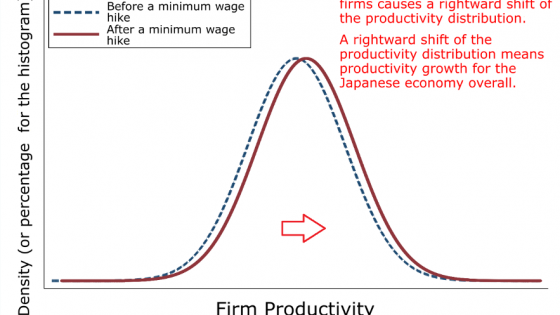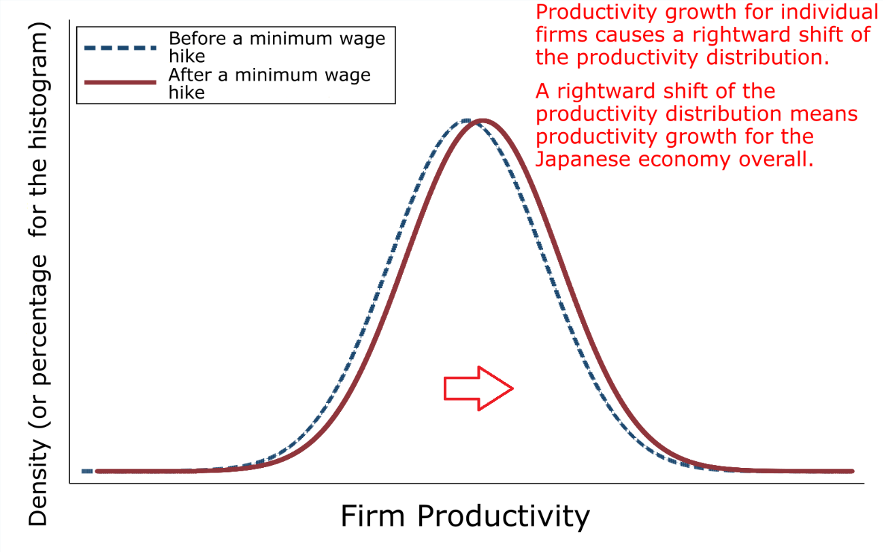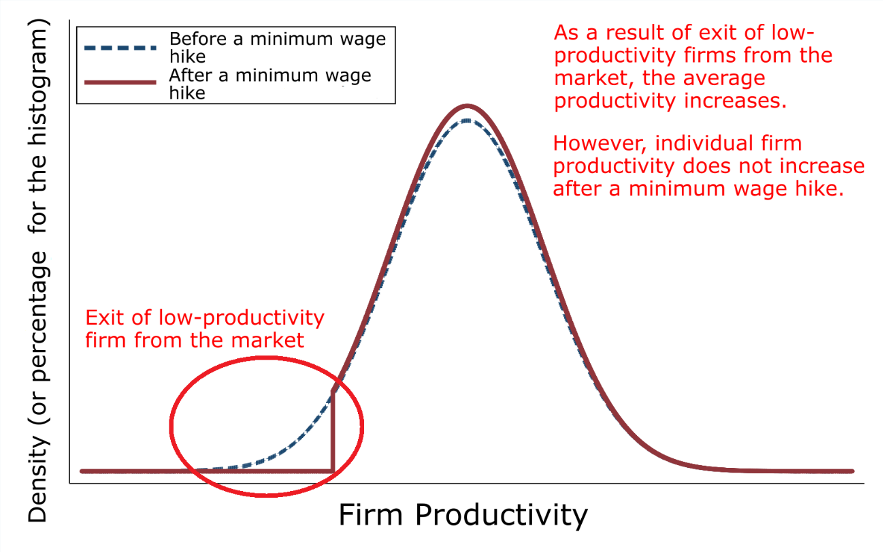The argument that minimum wage hikes bring productivity growth is attracting attention in Japan (Atkinson 2019a). As increasing productivity is one of the top priority challenges facing the Japanese economy under the current population decline, the idea of raising the minimum wage in order to spur productivity growth has piqued interest among policymakers. Does a minimum wage hike really lead to productivity growth? In this column, I hope to contribute to the policy debate on productivity growth by clarifying Atkinson’s argument, presenting a policy design approach, and reviewing the points of the argument from the viewpoint of economic theory.
Review of the argument that a minimum wage hike brings productivity growth
Atkinson (2019a), an ex-Goldman Sachs analyst, argues that minimum wage hikes bring productivity growth, referring to a recent finding from the UK (Rizov et al. 2016) which is attracting the attention of policymakers in Japan. Looking closely into his argument, one sees that Atkinson stresses the quality of management teams as a factor behind the lack of productivity growth in Japan. At the root of Atkinson’s argument is the question of how management teams can be made to take action through policy initiatives, since the cycle of productivity growth leading to wage growth is malfunctioning. Atkinson emphasises reversing the direction of this circular causality and arrived at the conclusion that the minimum wage should be raised in order to compel management teams to carry out the reforms that are necessary for increasing productivity.1
Policy design and incentives
By considering an incentive-based policy design approach, we can clarify the main points of Atkinson’s argument for reversing the direction of this circular causality. If we are to design a policy for the purpose of achieving wage growth, one option is to create a programme through which preferential treatment is granted to firms that raise wages. In this case, the government sets a certain condition and rewards firms if they take action that satisfies the condition. This policy approach has been adopted in Japan in order to promote wage growth supported by increasing productivity.2 The problem with this approach is that the status quo does not change at all unless firms take action in response to the policy.
Another approach is for the government to request that firms raise wages.3 Such a ‘request’ does not provide significant incentive to firms, nor is it legally binding, so it is presumed to have only a limited effect on wage growth. Ultimately, Atkinson’s argument appears to be that if the management team is left to act at their own discretion, nothing changes, diminishing the prospects for growth.
A minimum wage hike represents the idea of imposing a penalty, in particular, on firms that only pay low wages to employees. This policy approach is designed to give less-productive firms an incentive to increase productivity to be able to make the additional wage payments. Naturally, raising the minimum wage is also expected to have strong side effects, so it is desirable for policymakers to carefully analyse the situation while making use of expert knowledge in relevant fields.
Distinguishing between the concepts of productivity at the micro and macro levels
It is necessary to first review the potential mechanisms which may explain how a minimum wage hike can actually achieve the effect of increasing productivity. Here, I provide explanations that will help in coming to an intuitive understanding of the potential effects of the approach from the perspective of economic theory.
First, we need to distinguish between the concepts of productivity at the micro and macro levels. Productivity at the micro level means at the level of individual firms, while productivity at the macro level means that of the overall Japanese economy (i.e. aggregate productivity). Therefore, when discussing the impact of a minimum wage hike on productivity, we must consider whether productivity grows at the level of individual firms or at the level of the overall Japanese economy, or at both levels.
Individual companies’ productivity growth corresponds to a rightward shift of the productivity distribution
Individual firms’ productivity growth is considered to correspond to a rightward shift of the productivity distribution. Figure 1 shows an image of the productivity distribution shifting to the right after a minimum wage hike under the hypothesis that a minimum wage hike leads to productivity growth (Hypothesis 1)
Figure 1 Changes in the productivity distribution under the hypothesis that a minimum wage hike causes productivity growth for individual firms
Note: Prepared by the author. This figure shows an image of the distribution of the logarithmic value of total factor productivity, which is often estimated in empirical analyses.
If productivity increases in individual firms, the productivity of the overall Japanese economy also rises. In other words, productivity grows at both the micro and macro levels. Therefore, if it is empirically shown that a minimum wage hike causes a rightward shift, this could be evidence in support of policy implementation.4
Exit of less-productive firms corresponds to a truncation of the productivity distribution
Productivity growth resulting from the exit of less-productive firms from the market (Hypothesis 2) is considered to correspond to a truncation of the productivity distribution. Figure 2 shows an image of such a truncation around the time of a minimum wage hike that is caused by the exit of less-productive firms.
Figure 2 Changes in the productivity distribution under the theory that a minimum wage hike causes the exit of less productive firms from the market, in effect improving productivity growth for the overall Japanese economy
Note: Prepared by the author. This figure shows the distribution of the logarithm value of total factor productivity, which is often estimated in empirical analyses.
It is true that if less-productive firms are removed from the market, the aggregate productivity of the overall Japanese economy rises. However, it should be kept in mind that the productivity levels of individual firms that remain in the market do not rise after a minimum wage hike under Hypothesis 2. In other words, even if aggregate productivity increases at the macro level, individual firms’ productivity, which should be the target of the government’s productivity revolution initiative, does not grow.
Another point that needs to be kept in mind is the employment status of workers previously employed by firms removed from the market. If new employment is created at highly productive firms due to the shift in the market caused by dissolution of less-productive firms, it can be said that a desirable resource reallocation has been achieved. Therefore, whether or not workers who lose their jobs at the less-productive firms are absorbed into new positions in the more-productive firms is a key point.
As an economic theory concerning a selection of less-productive firms like the situation being described here, Melitz (2003) provides important policy implications in the field of international trade. He analysed the effects of a selection caused by trade liberalisation using an approach that incorporates heterogeneity into firm productivity. As highly productive foreign firms enter the domestic market after trade liberalisation, less-productive firms that were only able to be competitive on the domestic level are forced to exit due to negative profits. However, as highly productive domestic firms can then increase their production volume through exports as a result of trade liberalisation, workers who lose their jobs can be absorbed. The reallocation of resources from less-productive firms to highly productive ones due to such selection increases economic welfare.
What effects will a selection caused by a minimum wage hike bring? While less-productive firms that cannot meet the minimum wage threshold are expected to be removed from the market, it is unlikely that firms that are already highly productive will increase production volumes and employment instantaneously. When debating policy, it is necessary to carefully examine whether or not a selection mechanism achieves an efficient production structure through the reallocation of resources from less-productive firms to highly productive ones.
Summary: Towards productivity growth
As to question of whether or not a minimum wage hike causes productivity growth, my answer depends on which one of Hypothesis 1 or Hypothesis 2 is dominant. If individual firms carry out reforms to increase productivity in response to a minimum wage hike, a productivity-increasing effect will be observed. On the other hand, if a minimum wage hike merely results in the exit of less-productive firms from the market, a productivity-increasing effect will not be observed, as the hike will not lead to productivity growth for individual firms. Moreover, as the minimum wage level rises, firm profits are expected to decline in the short term. The real effect of a minimum wage hike on productivity will vary across countries and firms, since the relative strength of the effects of Hypotheses 1 and 2 determine the total effect and also depend on firm characteristics and market structure in different countries.
As increasing productivity is a top priority challenge, I believe that enhancing the skills of individual workers is particularly important. However, unless firms offer wages commensurate with workers’ skills, they cannot attract skilled workers or provide incentives for individual workers to invest in increasing their human capital. Firms are trying to change the traditional Japanese employment practices – such as lifetime employment, seniority-based pay, and mass hiring of new graduates – in a drastically changing business environment. I hope that this column provides an opportunity for constructive discussion on how to tackle the challenge of increasing productivity.
References
Atkinson, D (2019a), “The Reason Why Raising the Minimum Wage Is the Global Norm,” Toyo Keizai Online (in Japanese).
Atkinson, D (2019b), “The Fundamental Reason Why Minimum Wage Should be ‘Universal Nationwide,’” Toyo Keizai Online (in Japanese).
Kawaguchi, D (2018), “Why Are Wages Not Rising?—Removal of Composition Bias Using Panel Data”, Japanese Panel Study of Employment Dynamics—Thoughts on Working Styles in Japan 2018, Vol. 9, Recruit Works Institute (in Japanese).
Morikawa, M (2019), “Minimum Wages and Productivity: An Overview and Evidence from Japan,” RIETI Policy Discussion Paper 19-P-012 (in Japanese).
Melitz, M J (2003), “The impact of trade on intra-industry reallocations and aggregate industry productivity,” Econometrica 71(6): 1695–1725.
Prime Minister of Japan and His Cabinet (2016), “The General Meeting of the Japan Chamber of Commerce and Industry,” The Prime Minister in Action, 17 March 17.
Rizov, M, R Croucher and T Lange (2016), “The UK National Minimum Wage's Impact on Productivity,” British Journal of Management 27(4): 819–835.
Endnotes
1. Although Atkinson (2019b) argues that minimum wage should be universal nationwide, this report does not address this argument.
2. For example, Ministry of Health, Labour and Welfare provides business improvement subsidies for establishments that increase wages. The policy list provided by the government is available at https://www.mhlw.go.jp/stf/seisakunitsuite/bunya/koyou_roudou/roudoukijun/zigyonushi/shienjigyou/index.html and https://www.kantei.go.jp/jp/singi/katsuryoku_kojyo/dai2/siryou2.pdf.
3. In reality, Prime Minister Abe has requested the wage hike to companies several times (Prime Minister of Japan and His Cabinet 2016).
4. A research paper published recently by Morikawa (2019) based on the analysis of panel data of firms obtained through the Basic Survey of Japanese Business Structure and Activities by the Ministry of Economy, Trade and Industry concluded that there is no clear evidence that past minimum wage hikes brought productivity growth to individual firms. In empirical analysis, the use of firm-level micro data is particularly important to distinguish between correlation and a causation. An empirical identification issue among micro- and macro-level data is also emphasized in the explanation given by Kawaguchi (2018) with respect to the stagnant wage growth in recent years in Japan.






